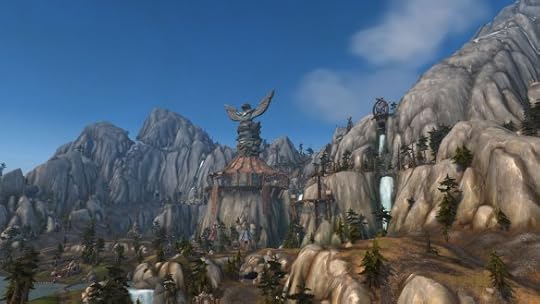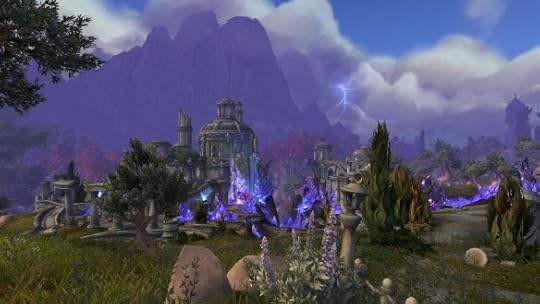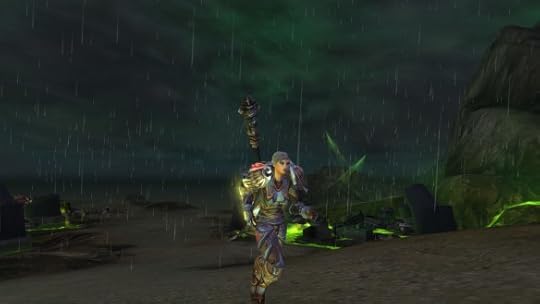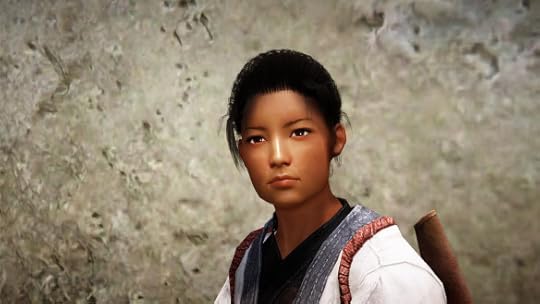Tyler F.M. Edwards's Blog, page 48
September 26, 2016
My Top Ten Fictional Races
One of my favourite things about speculative fiction is imagining non-human sentient races. It’s endlessly fascinating to me to imagine creatures who are not quite like us, who have different thought processes, different perspectives.
I thought it’d be fun to run down my ten all-time favourite non-human races within fiction.
We all know what’s going to be #1, but let’s pretend there’s some suspense.
10: Elves, The Obsidian Trilogy
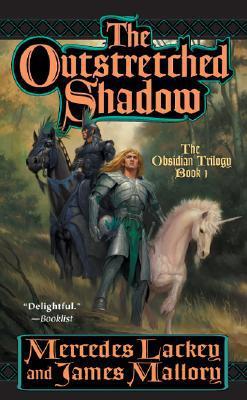 Innovation is good, but there’s also something to be said for taking the same old stuff and just doing it really, really well.
Innovation is good, but there’s also something to be said for taking the same old stuff and just doing it really, really well.
This is what Mercedes Lackey and James Mallory did with their Obsidian Trilogy. In many ways it’s an extremely generic high fantasy adventure, but it polishes all the old tropes to a brilliant lustre.
The best example of this the series’ Elves, as fascinating and alien a bunch as you’ll ever see. I loved the subtle intricacies of their culture, their bizarre yet somehow logical ideas of politeness.
9: Castithans, Defiance
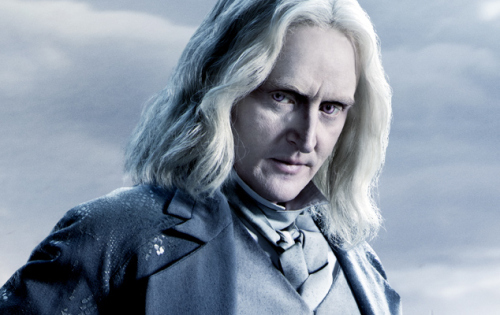 Castithans are one of those things I shouldn’t like, but do. Objectively speaking, they’re a nasty bunch. Dogmatic, brutal, conniving, unrepentantly sexist.
Castithans are one of those things I shouldn’t like, but do. Objectively speaking, they’re a nasty bunch. Dogmatic, brutal, conniving, unrepentantly sexist.
But if their society is cruel, it’s beautifully cruel. Gloriously cruel. They’re like if the painting The Scream was a society: horrifying, beautiful, disturbing, and fascinating all at once. There is such depth, such intricacy, and such artistry to everything they do that it’s easy to forget how horrible it all is.
8: Cylons, Battlestar Galactica
 There’s a lot of brilliant things about how the Cylons were depicted in the BSG reboot, but to boil it down to its core, they hit a great balance of making them clearly real people with real feelings, but also clearly not human. Always a difficult tightrope to walk.
There’s a lot of brilliant things about how the Cylons were depicted in the BSG reboot, but to boil it down to its core, they hit a great balance of making them clearly real people with real feelings, but also clearly not human. Always a difficult tightrope to walk.
The whole point of the series is that Cylons are not mere machines but feeling individuals, but they didn’t fall into the trap of making them identical to humans. They clearly have their own unique perspective and psychology, as seen in things like their “projection” ability.
7: Drow, Dungeons and Dragons
 The wonderful thing about the Elves is that they’re equally compelling as both heroes and villains.
The wonderful thing about the Elves is that they’re equally compelling as both heroes and villains.
I’m not the biggest D&D fan around, but I’ve always had a great fascination with the Drow. I think they’re perhaps the best example of Elves who are anything but noble.
There is something enticingly alien about the Drow. They come from a place without light, or life as we understand it; a place of darkness and mystery where those of us born under the sun are not welcome. Like any good Elves, they are beautiful and majestic, with an intricate culture, but whereas some Elves are virtuous, Drow are terrible and deadly.
6: Orcs, Warcraft
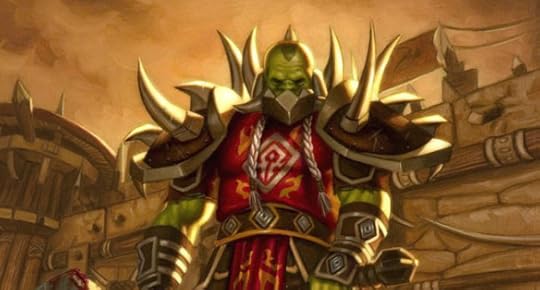 After the last few WoW expansions, I think the whole Warcraft community is a bit burnt out on Orcs, myself included.
After the last few WoW expansions, I think the whole Warcraft community is a bit burnt out on Orcs, myself included.
That said, that doesn’t change the fact that Warcraft’s Orcs are awesome. They are a fresh take on the archetype, not just savage brutes but a complex and multifaceted people. Over the years, they’ve been used to make all sorts of great points about the assumptions we tend to make, judging books by their covers, and how one society’s monster can be another’s hero.
Their story is an incredible rollercoaster of highs and lows, and even after all the terrible things they’ve done, it’s almost impossible not to feel sympathy for them. They destroyed themselves as much as they destroyed their foes.
5: Night Elves, Warcraft
 I like to make fun of the Night Elves. They’re dogmatic, xenophobic, smug hypocrites, and as a proud native of Quel’thalas, I’m somewhat obligated to dislike them.
I like to make fun of the Night Elves. They’re dogmatic, xenophobic, smug hypocrites, and as a proud native of Quel’thalas, I’m somewhat obligated to dislike them.
And World of Warcraft has certainly ill-served them. They’ve become little more than hippies these days.
But all that said, there’s still a lot about Night Elves that’s incredibly cool. The original vision of them being savage, feral Elves was a really fresh take on the archetype. They’re not Drow, and they’re not the traditional cultured Elves, either. They’re a very unique breed unto themselves.
Listen to Nightsong, remember the days when Ashenvale was a place outsiders feared to tread, and reflect on the terrible majesty of the Kaldorei.
4: Romulans, Star Trek
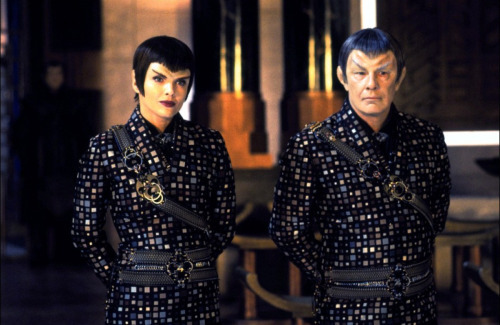 One of my favourite styles of villain is that of the cultured, sophisticated villain. They could crush you outright, but they’d rather spin such an intricate web of deception you prove your own undoing, and they’ll do it while finely dressed and sipping a rare vintage
One of my favourite styles of villain is that of the cultured, sophisticated villain. They could crush you outright, but they’d rather spin such an intricate web of deception you prove your own undoing, and they’ll do it while finely dressed and sipping a rare vintage
That’s the Romulans in a nutshell. They’re the bad guys, yes, but there’s also an incredible sense of history and culture to them. They’re better than you, and they know it.
I don’t think Star Trek has ever really explored the Romulans to the extent they deserve, but at the same time that sort of adds to their mystique.
3: Mantis-kinden, Shadows of the Apt
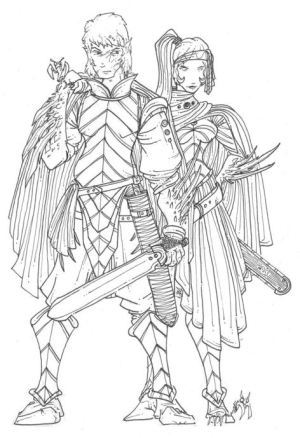 Adrian Tchaikovsky’s Mantis-kinden are similar to Elves in many ways. They’re forest-dwellers, they live in tune with nature, and they’re a relic of a long-forgotten time.
Adrian Tchaikovsky’s Mantis-kinden are similar to Elves in many ways. They’re forest-dwellers, they live in tune with nature, and they’re a relic of a long-forgotten time.
However, the Mantids are much harsher, more savage, and more bloodthirsty than Elves. They are graceful, but also terrifying. They’re not just a relic of an older time, but a relic of a darker and far more brutal time.
Of course, that just endears them to me all the more.
2: Protoss, StarCraft
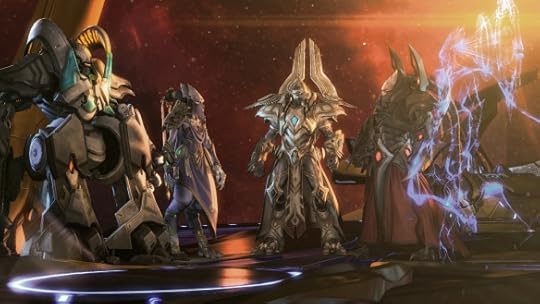 More than almost any other non-human race I’ve encountered in fiction, the Protoss manage to feel both convincingly alien and yet still like real people.
More than almost any other non-human race I’ve encountered in fiction, the Protoss manage to feel both convincingly alien and yet still like real people.
On the one hand, the Protoss are very clearly not human. Their long lives, their telepathy, their warrior culture, and their connection to the Xel’naga give them a perspective completely different from that of humanity.
But unlike many aliens in fiction, the Protoss are not just an archetype or a rigid set of personality traits. They are not a mono-culture. There is great diversity among them. This was true from their inception, and Legacy of the Void went to great lengths to further expand upon the various different Protoss cultures.
Think about it. How often does fiction bother to give non-human races a variety of nations with unique cultures? I’m sure it’s happened outside the Protoss, but I’m hard-pressed to think of any examples off the top of my head.
All of the Protoss cultures share the same warrior spirit, but how that identity manifests varies greatly, from the rigidly honour-bound Khalai, to the fiercely individualistic Nerazim, to the brutal Tal’darim.
Even within those broader cultures, there can be variation. Aiur’s society includes dogmatic hardliners like Aldaris, open-minded idealists like Artanis, curious scholars like Karax, and bombastic warriors such as Fenix.
This diversity has allowed some fantastic points about multiculturalism to be made throughout the Protoss story. The Nerazim were rejected by greater Protoss society for their “deviant” behaviour, but without them, the Protoss never could have survived the onslaught of the Swarm.
When the tables were turned, many Nerazim did not want to harbour the Khalai refugees, but without them, the Nerazim would have fallen in the End War — and all creation with them.
And beyond all that, it’s hard not to admire the honour, dedication, and sheer badassery of the Protoss.
Take the immortals. These are people who have been crippled and mutilated by combat. A human in that circumstance would consider death a mercy. But the Protoss willingly — gladly, even — volunteer to have their ruined husks implanted into giant war machines so that they can continue to serve their people for years, perhaps even centuries, to come.
“Uhn dara ma’nakai — our duty is unending.”
1: Blood Elves, Warcraft
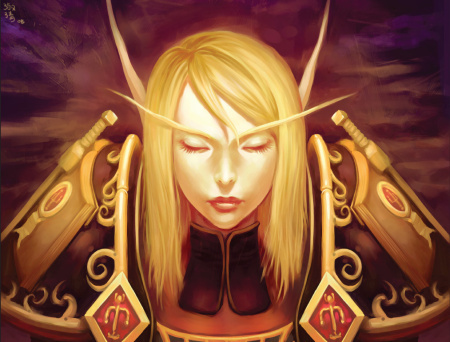 Yeah, this is the most unsurprising ending to a listicle in history.
Yeah, this is the most unsurprising ending to a listicle in history.
By now my love of the Sin’dorei is very well-documented. I’ve talked before about how they won my undying devotion by maturing along with me. When I was a child, they were a majestic if simplistic embodiment of goodness, and when I became a teenager, they evolved into something darker, edgier, and sexier — everything a teenage boy could want.
Their story has so many strong commentaries to make on issues like addiction, genocide, racism, and victim-blaming. Which isn’t to say that they are saints or without blame in their own downfall, but that just further deepens their profoundly complex themes. For the Blood Elves, there are no clear right answers. Nothing is ever simple.
They are one of the most fascinatingly complex moral studies in speculative fiction, their elegance and grace are unmatched, their tragedy is heartbreaking, their endurance is inspiring, and their sheer cool factor is undeniable.
Selama ashal’anore.
Honourable mentions:
My love for non-human races in fiction is such that there are many more favourites who didn’t make the list.
One thing Warcraft has never lacked for is fascinating races, so in addition to those mentioned above, I could also praise the Tauren, the Worgen, the Forsaken, the Pandaren, the Faceless, the Vrykul, and the Nerubians.
Adrian Tchaikovsky gifted us with no end of fascinating races in Shadows of the Apt, and in addition to the Mantids, Spider-kinden were always a favourite.
Star Trek’s aliens tend to be pretty bland as a rule, but they have come up with some good ones over the years beyond Romulans: Klingons, Borg (pre-Voyager), Trill, Tamarians, Denobulans.
The much-missed Myth franchise of video games was fantastic for coming with interesting new races instead of just relying on the same old archetypes. I especially liked the nightmarish Myrkridia and enigmatic Trow.
Ian Irvine is also pretty good at coming up with new concepts within fantasy, and I’m especially fond of the mighty and regal Charon.
Do you have any favourites I didn’t include on my list?
Filed under: Misc. Tagged: Battlestar Galactica, because Elves that's why, Defiance, Dungeons and Dragons, fantasy, sci-fi, Shadows of the Apt, Star Trek, Starcraft, The Obsidian Trilogy, Warcraft








September 22, 2016
Under the Burning Skies: Highmountain
I have now reached the final leveling zone of Legion, Highmountain. I’ve had the strange desire to actually progress beyond level 103, so I’ve decided to forego sending another fresh alt into Highmountain. Instead, Maigraith is taking the wheel again.
Highmountain continues Legion’s theme of shining a light on races other than humans and Orcs. This time the Tauren take center stage, something they’ve rarely gotten to do.
I’m not the biggest Tauren fan in the world, but I do like them, and I’m happy to see them getting some time in the spotlight.
Also, now that moose Tauren are a thing, I think we can confirm that Tauren are, in fact, the Canadians of the Warcraft universe.
On paper Highmountain is a zone I should really love the aesthetics of. It’s got snow, lots of trees, scenic vistas, and a bit of a wild edge. But in practice I found it the least visually appealing of Legion’s zones so far. It’s not ugly by any stretch of the imagination, but it’s definitely not as nice as the others, either.
It’s nicer at night, but unfortunately I don’t play at night very often.
I do like Thunder Totem, at least. It’s the closest thing to a new city we’ve gotten in a long time, and it has a nice homey feel. I almost wish it could have been the new hub for the expansion. Not that there’s anything wrong with Dalaran, mind you.
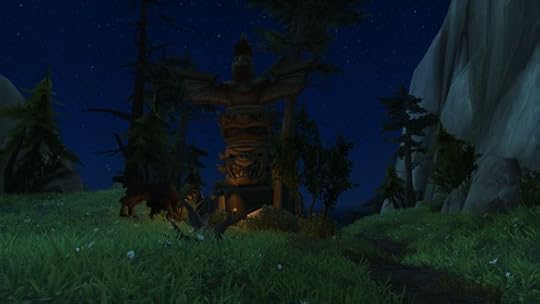 Although I’ve heard lots of horror stories about navigating Highmountain, I didn’t find it nearly as troublesome as Stormheim. Although I suppose being both a rogue and an engineer helps.
Although I’ve heard lots of horror stories about navigating Highmountain, I didn’t find it nearly as troublesome as Stormheim. Although I suppose being both a rogue and an engineer helps.
The story is a bit like Val’sharah’s in that it suffers from a certain degree of inconsistency, though not as severely.
A lot of Highmountain is not terribly memorable — mostly a lot of killing harpies — but there are a few points that are more interesting, mainly at the beginning and the end.
Early on, there’s a lot of going into the history of Highmountain, and in particular it does a lot to expand upon the story of one of the great heroes of Tauren history. Nice little sequel to War of the Ancients there. A few quests even send you back to relive history, which is always cool.
Then it’s a lot more dead harpies for a while, but then near the end there’s a pretty interesting twist that does a good job of reversing your expectations.
My run through Highmountain also, of course, included a jaunt through its dungeon, Neltharion’s Lair. On the whole a fun dungeon — visually interesting. They did a very good job of imparting a great sense of scale without making it a tediously long slog. Reminds me of Ahn’kahet that way.
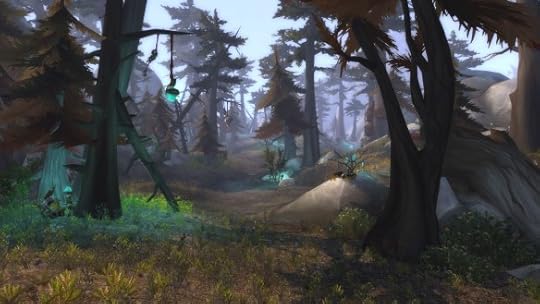 It did sort of confirm my impression that WoW’s once-legendary soundtrack is slipping, though. Most (all?) of the music in Neltharion’s Lair is re-used from Cataclysm, and that caused way more excitement in me than it should have.
It did sort of confirm my impression that WoW’s once-legendary soundtrack is slipping, though. Most (all?) of the music in Neltharion’s Lair is re-used from Cataclysm, and that caused way more excitement in me than it should have.
Finally, Highmountain is noteworthy for allowing us to finally meet a legend of Warcraft lore: Marcus of A Steamy Romance Novel fame. This comes alongside the latest entry into the franchise, A Steamy Romance Novel: Got Milk?
Which may well be the filthiest yet. Much like the “also, I seduced his wife” quest in SW:TOR, I don’t know how this got past the censors.
Funny. I always pictured Marcus as having black hair.
Overall, I enjoyed Highmountain more than Stormheim or Val’sharah, but definitely not as much as Azsuna.
Filed under: Games Tagged: fantasy, Under the Burning Skies, Warcraft, World of Warcraft








September 19, 2016
Review: Dark Matter, “But First We Save the Galaxy” (Season Finale)
Corporate war is looming. Based on knowledge gleaned from the alternate universe and the Seers, the Raza crew believes an upcoming corporate diplomatic conference will be attacked, sparking a conflict that will set fire to the entire galaxy. And they’re the only ones who can stop it.
 With some convincing, they manage to gain access to the conference via their Mikkei allies, and the race is on to find the bomb.
With some convincing, they manage to gain access to the conference via their Mikkei allies, and the race is on to find the bomb.
But there are complications. Oh, boy, are there complications.
Inspector Kierken of the Galactic Authority oversees the security for the conference, and he’ll jump at any chance to finally apprehend the Raza crew. Ferrous Corporation also has a strong presence on the station, and they’d love to get some payback on the crew for season one’s double-cross.
And then there’s Four. Or the man who used to be Four. Now emperor of Zairon and no longer any friend of the Raza crew, he has come to represent his planet’s interests at the conference.
This is Dark Matter, and it’s the season finale, so do I even need to say that things get really bad and really crazy really fast? I don’t think that’s even a spoiler; I think we all knew that pretty much everything was going to explode — figuratively, literally, or both.
As usual, the writers do a great job of keeping you guessing. It’s obvious something bad is going down, but it won’t be until pretty near the end you get a clear picture of just who is planning what.
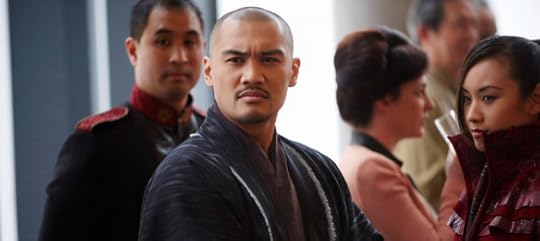 It is, simply put, an absolutely excellent episode from beginning to end. As tense and exciting as you could possibly ask for a season finale.
It is, simply put, an absolutely excellent episode from beginning to end. As tense and exciting as you could possibly ask for a season finale.
My only complaint is very, very minor, and it’s that we’ve rounded out the season without learning the full origins of Sally the android. They’ve been building to it all season, but nothing’s come of it.
But otherwise “But First We Save the World” is yet another entry in the “this is why I love Dark Matter” file.
There’s a bit more I want to say, but it crosses into spoiler territory, so I’ll save it for the end of the post and label it clearly.
Overall rating: 9.1/10
Now that season two is in the history books, I think it’s safe to say it was a significant improvement over season one — and season one was great. There was not a single bad episode in season two. Some were better than others, but overall the show has maintained an incredibly consistent quality level.
It’s actually been kind of frustrating for me as a reviewer because there’s only so many ways I can say, “Yeah, it’s pretty good.” I’m worried all my reviews are starting to sound the same because every episode is the just like the others. Fun, exciting, and keeping you guessing.
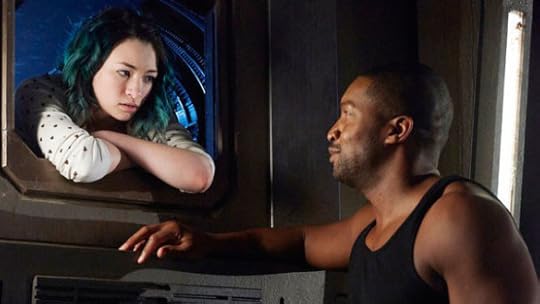 But I guess that’s what you call a good problem to have.
But I guess that’s what you call a good problem to have.
There’s good news, too: Dark Matter has already been renewed for a third season.
I can’t wait.
Spoilers here:
Seriously, spoilers here, stop now if you don’t want to read any.
So…
Four.
I’m very curious what they’re going to do with him next season. This is a lot worse than Six’s betrayal at the end of season one. That was the wrong thing to do, but it was somewhat understandable. Even before season two started, I had a pretty good idea of why he did it, and it was hard to view him too harshly.
Four, though, has crossed the Rubicon. I don’t see how there can be any coming back from this. Six was a conflicted man who made one bad decision. Four — or I guess Ryo now — has crossed into full-blown supervillain territory. I don’t see how the crew can ever forgive him. I certainly can’t see myself as a viewer forgiving him.
I wouldn’t be surprised if he became a main villain for the third season. Longer term, if things go really bad for him, I could maybe see him killing himself in a last ditch effort to regain his honour. Especially if Nyx doesn’t make it.
On that note, I wouldn’t think they’d want to kill Nyx off so soon after introducing her, but then again, they did it to Devon.
I’m not sure what I want to see. I don’t want to see her go; I was just starting to really like her. But if Ryo ends up responsible for her death, however indirectly, that adds a whole other layer of emotional intensity to his story.
How long until season three?
Filed under: Reviews Tagged: Dark Matter, review, sci-fi, TV








September 16, 2016
Under the Burning Skies: Azsuna and Warlock Woes
Two zones are down, and now I direct my attention to the haunted coastlines of Azsuna. I didn’t know too much about Azsuna going in, but I had heard it had a lot of connections to Highborne history and ancient magic, so my warlock seemed the obvious choice to be the first to set foot on its forgotten shores.
Azsuna is the first zone I’ve played in Legion that doesn’t feel like a clear attempt to recapture the magic of some region from World of Warcraft’s past. While I’m not opposed to the occasional shameless play to nostalgia, it’s good to know Legion is also capable of charting its own course.
Azsuna is also the first zone so far where I’ve encountered the Legion directly… which is rather strange when you think about it. I’ll need some more time to decide how I feel about the Legion not being seen in the new content very often; it has its pros and cons. But either way I’m glad to have at least one zone where we fight the demons directly, even if it’s only a relatively small part of the experience.
Undoubtedly the most memorable thing about Azsuna is its visuals, which are absolutely stunning. Every zone so far has been nice to look at, but Azsuna is just breathtaking. The somber ancient architecture, the shining ocean waters, the verdant plant life, the brilliant colours of the leylines… There is nothing about this zone that isn’t gorgeous.
Every WoW expansion has improved on the last when it comes to graphics, but Legion may represent a quantum leap forward not seen since Wrath of the Lich King. The depth and detail is unlike anything we’ve seen in this game before.
I can keep going for ages and still not do justice to just how pretty Azsuna is. It has to be seen to be believed — even my screenshots may not be entirely doing it justice.
 That’s not to say that Azsuna is all style and no substance, though. The actual content of the zone also impresses.
That’s not to say that Azsuna is all style and no substance, though. The actual content of the zone also impresses.
Azsuna’s storyline isn’t the best Blizzard’s ever done, but it is definitely the best of the expansion so far. I greatly enjoyed the tragic story of the Court of Farondis — doomed to eternal damnation for trying to do the right thing — and Prince Farondis himself is pretty much my new hero.
It was also nice to see Azshara again, however briefly. It’s a long way from the Azshara expansion I’ve been fantasizing about for the last several years, but it’s good to know Blizzard hasn’t forgotten her entirely.
It seems like slightly more effort was put into quest mechanics in this zone, too. I particularly enjoyed a quest where you experience what an NPC was doing while you were otherwise occupied, ultimately ending up with you (as the NPC) turning the quest in to yourself.
There are a few dull quest chains, but they’re the sort of thing you can easily skip on subsequent playthroughs.
 The zone’s leveling dungeon, the trollishly named Eye of Azshara, was also quite enjoyable. It’s very well-paced, and the final boss fight was an epic, visually spectacular experience.
The zone’s leveling dungeon, the trollishly named Eye of Azshara, was also quite enjoyable. It’s very well-paced, and the final boss fight was an epic, visually spectacular experience.
I did find the soundtrack in Azsuna a bit dull. Which, come to think of it, has been a bit of a problem throughout Legion so far… and in Warlords of Draenor. Is Blizzard’s excellent soundtrack finally slipping? That would be a real shame, as often the music has been among the most enjoyable things in WoW. It certainly makes the endless grinding a lot easier to deal with.
Another disappointment is that, despite the name, we learn nothing new about Azsune in this zone — she’s never even mentioned. I’ve been wanting answers about her basically forever, and I thought now I might finally get them. Maybe in another fifteen years or so…
Even with those complaints, though, Azsuna was a great ride. Easily the best zone of the expansion so far, with Eye of Azshara also being the best dungeon so far.
Warlock woes:
If anything truly detracted from the experience, it was my continued unhappiness with the state of warlocks.
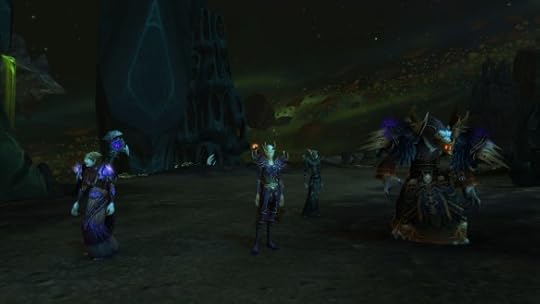 Really this is an excellent lesson in the power of inertia and nostalgia. I don’t doubt that I would have enjoyed the actual gameplay more as a demon hunter, or really almost any other class. Instead I chose to suffer through insane ramp-up time and no combat visuals to speak of purely because of the history I have with my warlock and my fondness for her as a character.
Really this is an excellent lesson in the power of inertia and nostalgia. I don’t doubt that I would have enjoyed the actual gameplay more as a demon hunter, or really almost any other class. Instead I chose to suffer through insane ramp-up time and no combat visuals to speak of purely because of the history I have with my warlock and my fondness for her as a character.
After finishing Azsuna, I got my second artifact, the Scepter of Sargeras, and I think I’ll try playing destruction again for a while. Thinking it might be my solo spec, while affliction is reserved for grouping.
These days choosing a spec as a warlock is really just picking how you want to suck. Do you want to be able to get up and make a sandwich while chaos bolt is casting, or do you want an eternity of ramp-up time coupled with an utter lack of combat visuals, or would you rather just give up fighting altogether and become a buff bitch for a bunch of mindless NPCs?
The one thing I can say is that the parts of being a warlock that don’t have to do with actually playing them are turning out to be pretty fun. I’m loving their class story, and their artifacts are pretty awesome.
I’ve had the absurd good luck to have both artifacts so far go excellently with my preferred outfits for the associated specs. Ulthalesh might as well have been designed for my affliction outfit, and the red tint for the Scepter goes very well with the blood mage look I prefer for destro.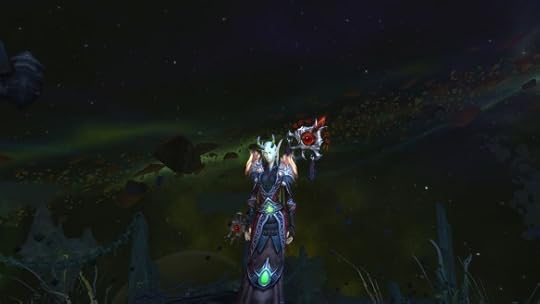
Filed under: Games Tagged: fantasy, The Mustering of Azeroth, Under the Burning Skies, Warcraft, World of Warcraft








September 13, 2016
Chris Metzen Is Retiring
As of last night, Chris Metzen has announced his retirement from Blizzard entertainment, and apparently from the gaming industry entirely.
 While it was bound to happen one day, it’s still a big shock to any Blizzard fans. And I’m one of the biggest Blizzard fans around.
While it was bound to happen one day, it’s still a big shock to any Blizzard fans. And I’m one of the biggest Blizzard fans around.
For the last twenty years, Metzen has been the driving creative force behind Blizzard’s games. Warcraft, StarCraft, Diablo, Overwatch — they’re all his babies.
Think back to where it all began, to Warcraft: Orcs and Humans. This was originally intended to be a Warhammer game, but the licensing fell through, so Blizzard had to create its own IP for it. Over the next twenty years, Metzen was able to spin something initially derivative into a unique and incredibly vast and vibrant universe that has become one of the biggest names in gaming — one of the biggest names in popular culture period.
And that’s just one of the many beautiful worlds he’s created.
I can’t overstate the influence Metzen has had on my life. I was about five when I first played Orcs and Humans. I didn’t know how to spell my own name yet, but I knew how to train footmen. I knew we couldn’t let Stormwind fall to the Horde.
And then later came Tides of Darkness, and it rocked my world. And so did StarCraft. And Reign of Chaos. And so on and so forth until I spent so much time playing World of Warcraft that I got a job writing about MMOs for a living.
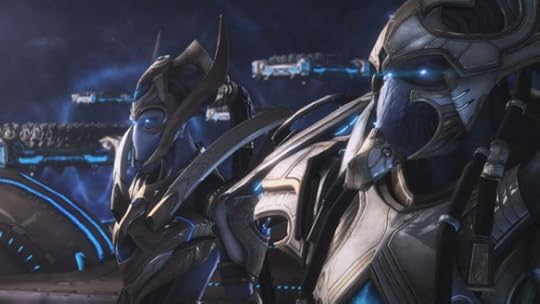 Metzen has of course influenced my fiction writing tremendously as well. I’m eternally trying to capture some of the bombast and vibrancy of Blizzard’s worlds in my own writing — I leave it to my readers to judge how successful I’ve been.
Metzen has of course influenced my fiction writing tremendously as well. I’m eternally trying to capture some of the bombast and vibrancy of Blizzard’s worlds in my own writing — I leave it to my readers to judge how successful I’ve been.
I love the worlds, the peoples, the characters Metzen has created. There’s a spark of beauty and colour to them that is totally unique.
That’s not to say Metzen is perfect. He has many flaws as a writer, and at times I’ve strongly disliked the choices he’s made.
But I could never bring myself to hold it against Metzen himself, because even when he took the wrong path you could feel his tremendous passion shining through.
That is what makes Metzen so special as a writer and a world-builder. His passion. I have never seen anyone display a love and childlike joy so pure as Metzen did when discussing the worlds and the stories he had created. I have never doubted for a moment that he loves Warcraft, StarCraft, and the others at least as fiercely as I do, and probably even more so.
His joy was infectious, and it always shone through in everything he created. It’s that vigour and passion that makes Blizzard games so much brighter and more colourful and more alive than any others, and it’s that quality that’s kept me coming back to them time and again no matter how else they might stumble.
 The news of his retirement makes me tremendously sad. Not because I’m worried that Blizzard’s games won’t be the same without him, although I definitely am, but because I know a world where Metzen isn’t creating and sharing his passion and shouting to crowds in his best Thrall voice and generally acting like the biggest, happiest kid is a world with just a little less joy in it.
The news of his retirement makes me tremendously sad. Not because I’m worried that Blizzard’s games won’t be the same without him, although I definitely am, but because I know a world where Metzen isn’t creating and sharing his passion and shouting to crowds in his best Thrall voice and generally acting like the biggest, happiest kid is a world with just a little less joy in it.
I’d say more, but I’m too full of feels to even be coherent.
Lok’tar ogar and en taro Adun, Metzen. We love you, man.
Filed under: Games, Misc. Tagged: Diablo, fantasy, Oh god why, Overwatch, sci-fi, Starcraft, Warcraft








September 12, 2016
Reviews: Dark Matter, “Wish I’d Spaced You when I Had the Chance” and “Sometimes in Life You Don’t Get to Choose”
Well that’s bound to be my longest post title ever.
 For whatever reason two episodes of Dark Matter popped up in my iTunes queue today (well, not today, but it was today when I wrote this), so now you get two reviews for the price of one!
For whatever reason two episodes of Dark Matter popped up in my iTunes queue today (well, not today, but it was today when I wrote this), so now you get two reviews for the price of one!
The price of one is nothing, so it’s not a great deal, but…
“Wish I’d Spaced You when I Had the Chance”:
We now bring you the third entry in Dark Matter’s “look how close the crew has gotten” trilogy. It’s also the second instance of Dark Matter following Murphy’s Law of Shore Leave. It’s good to stay true to traditions, I suppose.
The crew of the Raza has landed at an isolated colony to resupply, but of course things don’t go as they’d hoped. Two, Four, and Nyx are recognized at a bar, and the station is put into lockdown as the Galactic Authority swoops in to apprehend them.
To make matters worse, Five is abducted by some ne’er-do-wells, and only Three can save her.
It is to this latter plot that the lion’s share of the attention is given. Generally the idea is to once again show how close the Raza crew has become, in stark contrast to the suspicion and distrust of season one.
 As noted above, this is the third episode in a row to do that, and while that might seem excessive, I think it was necessary. There was a lot of distrust to work past, and generally it’s pretty gratifying to see the crew come together like this.
As noted above, this is the third episode in a row to do that, and while that might seem excessive, I think it was necessary. There was a lot of distrust to work past, and generally it’s pretty gratifying to see the crew come together like this.
“Wish I’d Spaced You When I Had the Chance” isn’t quite as good as “Going Out Fighting” was, but it’s better than “Take the Shot.”
It’s still a bit difficult to look past how inconsistent Three’s writing has been. They did too good a job of making him an asshole out of the gate, and then were too sudden to try to humanize him. A slower, more natural progression could have worked better.
That said, they’ve done a much better job of balancing his character this season than in season one, so this episode is much easier to swallow now than it would have been in the past. In the end it works out, more or less.
Overall rating: 7.8/10
“Sometimes in Life You Don’t Get to Choose”:
Four has reached the limit of his patience. Desperate to regain his throne and save his people from a losing war, he makes the extreme choice to reactivate his old memories from before Five’s wipe.
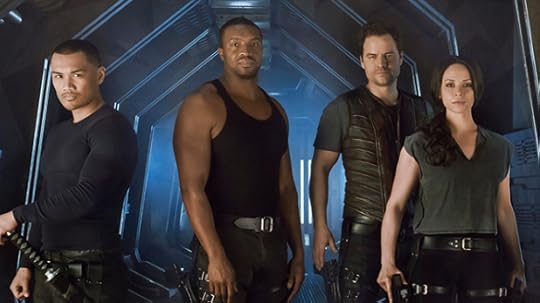 The rest of the crew is uncertain how to feel about the new/old him — with Five and Nyx being especially affected — but they choose to place their faith in him.
The rest of the crew is uncertain how to feel about the new/old him — with Five and Nyx being especially affected — but they choose to place their faith in him.
Thus, it’s time for something we’ve been waiting for since season one: Four returning home to claim his place as the emperor of Zairon.
He immediately reconnects with a general he knows can be trusted. Confronted with Four’s ruthless determination and the power of the blink drive, he readily agrees, and they begin to work together to bring Four’s plan to fruition.
Right away, though, something isn’t right. The efforts of Four and his allies are constantly disrupted by the empress and her forces, and some begin to wonder if Four’s people are as trustworthy as he believes.
There’s a lot more that I could say about this episode, but I’m trying to stay true to my policy of avoiding major spoilers. This one of most eventful episodes in Dark Matter’s history, if not the most eventful. That’s both its greatest strength, and its greatest weakness.
This is one of those episodes that changes everything. No matter what follows, Dark Matter will never be the same.
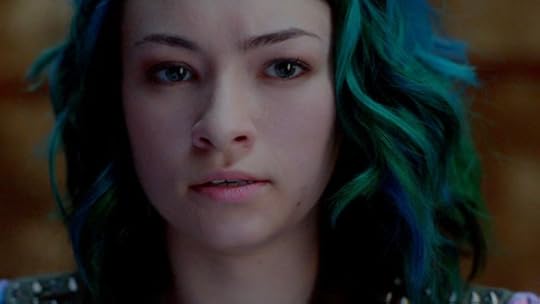 On one level, that’s awesome. There are some great twists to be found, and much of what makes Dark Matter so great is on full display here: action, suspense, humour, and people underestimating Five and then really regretting it.
On one level, that’s awesome. There are some great twists to be found, and much of what makes Dark Matter so great is on full display here: action, suspense, humour, and people underestimating Five and then really regretting it.
But on the other hand, they just crammed far too much into a single episode. The events of “Sometimes in Life You Don’t Get to Choose” could have easily been spread out over two or even three episodes. Compressing it all into one hour makes it feel rushed, prevents each plot and twist from getting the full attention it deserves.
Sometimes I really miss the days of sci-fi shows have 20+ episode seasons.
The implications of this episode are awesome, but the episode itself ends up being a bit inconsistent.
Overall rating: 7.5/10
Filed under: Reviews Tagged: Dark Matter, review, sci-fi, TV








September 10, 2016
Under the Burning Skies: Val’sharah
With the rain and the thunder of Stormheim behind me, I now turn my eyes to the lush groves of Val’sharah for my second Legion zone.
 As this is an area steeped in the culture and history of the Night Elves, it seems only appropriate that I send my monk. With the Wanderer’s Companion in hand and the backing of the Order of the Broken Temple, she is ready to teach the Legion to fear the night.
As this is an area steeped in the culture and history of the Night Elves, it seems only appropriate that I send my monk. With the Wanderer’s Companion in hand and the backing of the Order of the Broken Temple, she is ready to teach the Legion to fear the night.
Andu-falah-dor.
Val’sharah-sharah, whatever will be, will be…
Just as Stormheim was a clear play to Wrath of the Lich King nostalgia, Val’sharah is a clear throwback to old Night Elf zones like Teldrassil and Ashenvale. Visually, it’s almost exactly a graphically updated Ashenvale, and the music is deliberately similar.
I have less fond memories of those areas than I did for the Howling Fjord, so the play to nostalgia isn’t as effective for me as it was in Stormheim.
I do like Elves, though, and this is very much the Night Elves’ show. The whole zone is so unrelentingly Elfy I can hear Syp squirming from here — an image which can only endear me to the zone.
September 7, 2016
Under the Burning Skies: Stormheim, Artifacts, and More
Now that World of Warcraft once again has a new setting that I care about, I plan to take an in-depth look at each new zone as I play through it, just like I did back in Pandaria. Except this time, we’re not venturing into the mists; we’re battling under the burning skies.
 In keeping with the Mustering of Azeroth, I’ve also decided that I’m going to play through each zone on a different character my first time through.
In keeping with the Mustering of Azeroth, I’ve also decided that I’m going to play through each zone on a different character my first time through.
To start, Maigraith ventures into Stormheim.
But first…
One thing that has surprised me about Legion is the wealth of pre-max level content outside the standard questing zones. That’s not something we’ve really seen before — at least not on this scale. It does sort of screw up my desire give each zone its own neat little post, but I’ll soldier on.
Firstly, there’s artifacts. I knew about artifact quests going in, but they’ve turned out to be far more lavish and involved than I expected.
Put simply, I think artifacts are probably the best thing to happen to WoW in years. Artifact quests are absolutely fantastic, full of excellent story-telling, epic adventure, and an unusual (and welcome) level of challenge for WoW’s solo content.
My favourite so far is probably Ashbringer — because Ashbringer — but the brewmaster artifact (Fu Zan, the Wanderer’s Companion) is a very close second. It was almost a microcosm of Mists of Pandaria as a whole — fun and whimsical at times, but deadly serious where it counted.
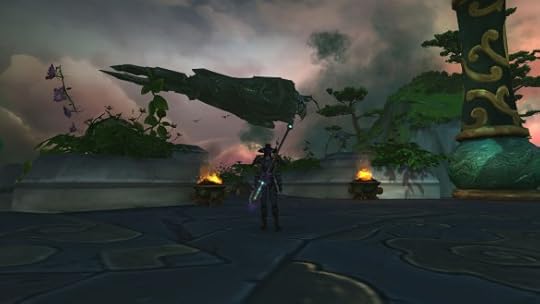 Afterward it occurred to me there was a double purpose to all of the Monkey King’s tasks. On the surface he just wanted me to brew him some beer, but in the process I basically saved Pandaria’s food supply. Clever.
Afterward it occurred to me there was a double purpose to all of the Monkey King’s tasks. On the surface he just wanted me to brew him some beer, but in the process I basically saved Pandaria’s food supply. Clever.
I adore how much the artifact quests utilize the entire game world, not just the new content. It makes the world feel so much richer and more alive, and it once again hammers home that nowhere is safe from the Legion.
This probably the first time in WoW’s history it’s matched the cinematic scale of the old RTS games.
On the other hand, I’m less impressed with the new class halls. I’m still not clear on what the actual point of them is supposed to be. I like the class-specific storylines so far — adventuring with the Black Harvest especially — but I don’t see why they need to be tied to a somehow even more half-baked version of garrisons.
And I really don’t like what they’ve done with professions. I think the idea was to make them a bit less boring, and that’s a noble goal, but in practice it seems like all they’ve done is taken a tedious, unrewarding chore and made it even more tedious and unrewarding.
Pinin’ for the fjords:
A lot of Legion seems to be a calculated attempt at playing to nostalgia of longtime WoW veterans, and Stormheim is one of the clearest examples yet. It’s basically the Howling Fjord 2.0.
The environments are similar, the musical callbacks are not even remotely subtle, and the subject matter and story are eerily close to that of Wrath of the Lich King’s eastern starter zone.
Mind you, I like the Howling Fjord, so none of that is necessarily a bad thing.
It also struck me that Stormheim feels much more like a sequel to Mists of Pandaria than Warlords of Draenor ever did. Right away you’re back on the Skyfire with Admiral Rogers and Mishka, and the early quests have a feeling of being lost in a strange land that echoes the Jade Forest. It’s almost like WoD never happened.
Again, not complaining.
 Overall, I enjoyed Stormheim, but not as much as I was expecting to. I do very much appreciate the Norse flavour of the zone — though the constant mispronunciation of the J’s is driving me up a wall — but there aren’t a lot of big revelations or “wow” moments, God-King Skovald is just a much duller version of Ymiron, and boy is it a frustrating zone to navigate.
Overall, I enjoyed Stormheim, but not as much as I was expecting to. I do very much appreciate the Norse flavour of the zone — though the constant mispronunciation of the J’s is driving me up a wall — but there aren’t a lot of big revelations or “wow” moments, God-King Skovald is just a much duller version of Ymiron, and boy is it a frustrating zone to navigate.
Is it my imagination, or has Blizzard’s decision to scale back on flying coincided with zones becoming much more difficult to navigate from the ground? Yo, dawg, we heard you like cliffs…
Similarly, the zone’s associated dungeon, Halls of Valor, is good but not great. It’s very pretty, but it has a bit too much trash for my taste. TSW has spoiled me in this regard.
The one thing I did really appreciate about Stormheim is its weather. Obviously, WoW has had weather effects for a long time, but never before have they been so dramatic — not even in rain-drenched Pandaria.
When the rain blows into Stormheim — which it does often — the entire character of the zone changes. It gets much darker, and the gloom and driving rain gives the area a much grimmer, bleaker feeling. It’s incredibly beautiful, albeit in a very stark way.
 Also, man do I ever want playable Vrykul now.
Also, man do I ever want playable Vrykul now.
Like, so bad.
So, so bad.
* * *
So right now Legion seems to embodying the wildly inconsistent quality we’ve come to expect from World of Warcraft over the years.
Filed under: Games Tagged: fantasy, The Mustering of Azeroth, Under the Burning Skies, Warcraft, World of Warcraft








September 5, 2016
Review: Dark Matter, “Take the Shot” + New Writing
Do androids dream of electric sheep?
 Maybe some do, but the Raza‘s apparently dreams of a house in the woods.
Maybe some do, but the Raza‘s apparently dreams of a house in the woods.
Androids don’t normally dream, though, and Sally’s not the only one having visions. Two, Three, and Four find themselves tormented by hallucinations from their past.
All this puts the focus squarely on Sally and her abnormal behaviour. The program she initiated to judge her own actions is reactivated, and it paints a grim picture of Sally’s “malfunctions.”
The crew begins to question their faith in her — with the exception of Five, who remains as fiercely loyal as ever. As the ship’s problems escalate, the crew begins to contemplate extreme solutions.
The point of “Take the Shot” seems to be similar to that of the last episode. That is, they’re trying to show the bond that’s developed between the Raza crew members. It’s not quite as effective in that goal as “Going Out Fighting” was, though.
The crew seems too quick to shift from one extreme to another when it comes to their view of Sally. There’s no consistency, and it can feel a bit forced.
 I think the idea was to show the crew coming to fully accept Sally as an equal, but in practice it almost feels like the opposite is true. It seems more like they’re grudgingly acknowledging that they need her. There’s little feeling of genuine warmth to it.
I think the idea was to show the crew coming to fully accept Sally as an equal, but in practice it almost feels like the opposite is true. It seems more like they’re grudgingly acknowledging that they need her. There’s little feeling of genuine warmth to it.
I’m almost wondering if Sally might be better off without her human companions. They don’t seem to care about her anywhere near as much as she cares about them.
Again, Five is of course the exception. She spends the entire episode fighting tooth and nail for her mechanical friend. At this point I’m struggling to imagine how Five could get any more lovable.
I was also hoping that we might get some reveals as to how Sally came to be the way she is, but the mystery remains unanswered.
I appreciate what they were going for, and I like that Sally is getting more time in the spotlight, but it could have been handled better.
I still think it’s awesome seeing Anne Mroczkowski on this show, though.
Overall rating: 7.1/10
New writing:
I’ve had a few more articles published at MMO Bro over the last few weeks. I’ve compared popular Eastern and Western MMOs, looked at terms only true MMORPG fans understand, and examined why reputation grinds suck and how to fix them.
Also, if you missed my last post, I’ve posted my first new short story in a while. I’d appreciate any feedback you might have.
Filed under: My writing, Reviews Tagged: Dark Matter, review, sci-fi, TV, writing








September 3, 2016
Original Fiction: Lady of the Dawn
For the last little while, I’ve been having a real struggle being productive when it comes to fiction writing. The reasons for that too varied and complex to get into right now.
Nonetheless, I have been able to put out a few short stories here and there. Lady of the Dawn is one of them. I’m not entirely sure how well this one turned out, but that’s where you come in. Feedback is welcomed, constructive criticism included.
Lady of the Dawn takes place in the same universe as The Wounding, but they’re fairly disconnected stories, so you don’t need to have read that first.
One other note-worthy thing before I get into the story: Its protagonis was one of the characters I built when playing Black Desert a few months ago. She was one of the bigger successes, being a nearly perfect match for how I picture her in my mind.
Lady of the Dawn
© 2016 by Tyler F.M. Edwards.
To some, hope is a promise for a better future. To others, it is blind faith, a province for fools. Some see it as simply the knowledge that the sun will rise tomorrow.
To Artica, hope had never been anything but an idea.
* * *
She slowed from a trot to a careful walk, watching her footing in the dying light. Her hooves made little sound on the leaf-strewn forest floor, but occasionally they would clop on something harder – ancient paving stones. Her breath misted in the chill air, and the last of the day’s sunlight glinted orange on the spiral horn thrusting proudly from her head.
There was a subtle wrongness in the air, a prickling at the edge of her mind. This was the place.
With a thought, she transformed. Where a mighty beast with a black coat and glossy mane had stood a moment before, there was now a short, solidly built woman. All muscle and taught readiness, her stern face bore the olive skin — hers a duskier shade than most — and almond-shaped eyes of her people, the Karani, the Children of Sun and Sky.
Keyed to her own innate magics, her barding transformed along with her, becoming gleaming plate and mail. A kite shield emblazoned with the rising sun hung on her arm, and a long sword was sheathed at her belt. An open-faced helm concealed her ebony hair, and a tabard of white and gold marked her as a follower of Siel, Lady of the Dawn. The goddess of hope.
She felt her palms sweat within her gauntlets, and with a hiss of steel, she drew her blade.
The light was almost gone, and she knew she had made a mistake. With the coming of night, the power of her goddess would fade, and the advantage would swing to her quarry’s favor. She should have waited until tomorrow, but her impatience and frustration had gotten the better of her.
She had never been supposed to complete this trial. They had expected her to fail, to give up as she traveled to the far wilderness and tracked an enemy who left no trail. She had needed to prove them wrong, but in her pursuit of that, she had displayed the very lack of discipline that made her masters doubt her.
It was too late to turn back now.
* * *
Artica’s first memories were of terror.
Long ago, her people had lost their homeland, the Jan’il Plains. Defeated in the All War, they had fled into the forests of the north, forming a desperate alliance with the Elves, Dwarves, and Merfolk to create the Great Fellowship. Artica’s namesake, Great Queen Artica, had broken the power of the enemy and won the day for the Fellowship, but the Karani had been too devastated to return home.
Then the Bonru had come. Barbarians from another world, their jealously had made them turn on the Fellowship. A mongrel race without magic, they had failed in their attempt at conquest, but yet the Bonru had endured. Retreating to the Jan’il Plains, they had remained a cancer on the world, never a serious threat but always just strong enough to deny the Karani their homecoming.
The Karani still loved the sun-soaked plains, though, and would often take pilgrimages to visit their war-torn homeland.
Artica’s family had died on such a pilgrimage.
She had been but a small child, only fifteen years old, but her parents had wanted her to see the land their people so loved. For her early memories to be of endless skies and galloping across a sea of grass.
Then the Bonru had come.
Her parents had stashed her in a wagon, buried beneath blankets, gear, and boxes, and she had cowered and wept as screams filled the air. She could still hear the guttural shouts of the Bonru ringing in her ears, though she had been little more than a babe at the time.
A few phrases they had repeated over and over, and though none among the Karani or their Elven allies fully understood the Bonru language, she had eventually found an old veteran who had been able to translate them. “Were-Unicorns” and “squint-eyes.” Slurs the Bonru hurled against her people.
Somehow, even after everyone else was dead and the Bonru had begun looting, they had never found her, perhaps thinking her just a pile of cloth. She had simply lain perfectly still, struggling to breathe against the terror choking her.
She had refused to move even long after she had stopped hearing the raiders, but come nightfall, the chill in the air drove her to seek better shelter. She thanked Siel for the darkness that had obscured the details of the gore-soaked heaps of flesh that had once been her friends and family.
She had fled across the plains, galloping as fast as her little legs would take her, and eventually, shaking with exhaustion and sorrow, she had reached the refuge of the Home Forest. There, she’d had the fortune to stumble across some Elven Runners, who had seen her to safety.
That had been more than two hundred years ago now. The Bonru that had killed her family were all long dead, for their race lived vastly shorter lives than Elves or Karani, but still the wounds were raw. She felt that pain every day, gnawing at the edge of her psyche, sucking the color from life.
* * *
She scanned the overgrown ruins, sword gleaming in the twilight. The remnants of some forgotten battle from centuries past, as was her quarry.
She felt a prickle on the back of her neck, an unearthly chill, and she spun, ready to strike, but only more stone and trees met her gaze.
Every warrior-priestess of Siel was tasked with a mission to prove themselves as the final part of their initiation. Artica’s task was to bring down a shade, the tortured vestige of a person who had died in terrible pain or fear.
Driven mad by their torment, shades sought only to rip the life force from the living in the vain hope of regaining what they had lost. They were a menace, and it was the duty of men and women like Artica to end their threat wherever it appeared.
She felt another chill, stronger this time, along with a rustling of branches, and she whirled. Living shadow leapt forth from the trees. Vaguely shaped like a person, ragged tatters of dark cloth hung upon its darkened form, and twin pinpricks of crimson light gave the illusion of eyes.
Rather than dodging, she rushed forward, raising her shield, and slammed into the shade head-on. The impact rattled up her arm, and the shade’s semi-corporeal form shuddered, flickering. She followed up with a slash from her sword. Slicing through the shade provided almost no resistance, and its form flickered again, almost fading.
She readied for a final blow, but then she felt another, deeper chill. Before she could react, shadowy claws reached out to grab her from behind. Cold, sharp pain like knives of ice shot through her, and she glimpsed two more shades assailing her.
Of course, she thought.
* * *
Artica’s life had never been easy.
When her family had died, her grandparents had taken her in, but they’d had her mother late in life, and they were old and frail by the time Artica had come to them. They had not been up to the task of raising a little girl. Certainly not one who woke up screaming every other night. Not one prone to fits of temper and randomly acting out, just for the sake of feeling something again.
She had picked fights with other children over the smallest things. She had threatened to run away. She had said things she couldn’t take back.
She regretted it all now. Her grandparents had shown her nothing but kindness and patience, beyond what she had deserved, but never had she showed her gratitude.
And now it was too late.
Her grandmother had died when Artica was in her nineties – physically mature, but still essentially a child. Sixty years later, her grandfather had followed. Her father’s parents had passed long before. She was all alone now.
So when she went hunting for a shade and found three, she was not surprised. Priestesses of Siel were supposed to fill their hearts with hope, but she had always expected the worst.
* * *
The shades latched onto her shoulders, their insubstantial hands nonetheless as strong as vicegrips. Thin lines of amber light began to flow from her body to the shades, and her back arched as indescribable pain tore through every inch of her body.
She screamed, the cry echoing through the forest and sending birds scattering from the trees.
The pain shut down all rational thought. It drowned out all her senses.
Only one thought remained in her mind, somehow standing against the agony’s onslaught: the image of a beautiful woman in shining armor, her sword held high, her form radiating the pure light of dawn itself.
“Siel!” she cried.
For a brief moment, golden light shimmered across her armor, and the shades recoiled as if struck. Instantly, the pain ceased, and she sagged in relief, but she could not afford even a moment’s rest. She rushed forward and swung at the first shade, her sword tearing through it and scattering its form into nothingness.
She spun, raising her shield, as the other two shades regrouped.
At that moment, the sun plunged beneath the horizon, throwing the forest into shadow.
* * *
The day after she had come to live with her grandparents, her grandmother had taken her aside and told her about Siel.
“After every night, there is a dawn,” she’d said. “Siel sees that it is so. She is the end to all bad things, a happy ending to every story.”
“Then why is my story so sad?” Artica had asked.
It had taken her grandmother a long time to answer, and when she did, her voice had been hoarse, but she’d said, “Your story isn’t over yet.”
Artica had been follower of Siel ever since that day.
In her darkest moments, she had prayed to her goddess for guidance. When she had been alone, she had felt the presence of the Lady of the Dawn at her side. And when she had come of age, she had pledged herself to the priesthood to fight in service of her deity.
Her training had not been easy, for nothing ever was. She had clashed often with her superiors and her fellow students. They had not approved of her cynicism, her hardness.
And in fairness, not all her challenges had been inflicted by others. She had struggled to channel the power of the goddess even as it came easily to her peers. How could she embody the essence of hope when she herself had never truly felt it?
Many had tried to convince her to abandon her dream. Some had done so gently and with kindness. Others had been more harsh. They had sent her on an impossible mission to prove herself, traveling to the distant wilds to hunt a dangerous and virtually untraceable enemy.
Bit she had kept going. She had refused to give in, to lose the only thing left that mattered to her.
* * *
She scanned the gloom, noting the little dots of red light – the only clues to the shades’ location. As the light faded, the air chilled, and she felt the power of her goddess weaken.
“Siel, light my path,” she prayed.
The shades were closing in. She would not survive if they started to feed again.
“Siel, guide me through the night,” she continued, her voice rising.
The shades were almost upon her.
“Siel, bring me safely to the dawn!”
The sun on her shield flickered and flared to life, blazing with light: a new dawn within the forest. The light boomed forth, obliterating one shade immediately. The other sought to flee, but she turned her shield upon it, roaring her fury, and it could not escape the light of dawn.
She dropped to her knees, panting. Sweat ran down her brow and stung her eyes.
Some minutes later, she hauled herself to her feet and collected the shreds of darkened cloth that were all that remained of the shades. They would serve as proof of her deed. Then, she prepared for the long journey back to the city, where she would at last claim her place as a priestess of Siel.
She knew that this would not be the end. She would still struggle to balance her goddess and the ache in her heart. She would still wake in the night, sweating and panicked. She would still have to fight to control her temper as it flared up in the face of the slightest provocation.
But she would endure.
For Artica, hope was not a promise of an easy life or a balm to end all pain. It was simply her own conviction that someday, somehow, all her suffering would be worth it. That all her long centuries of struggle had not been in vain.
That her story was not over.
Filed under: My writing Tagged: because Elves that's why, fantasy, original fiction, stories, writing









